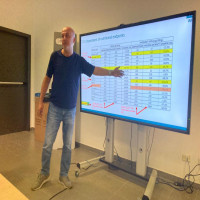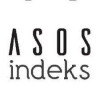Research Article
Aim & Scope
To share the results of scientific research, examination and project studies in the field of gastronomy and culinary arts; to convey current information and developments in this field to the target audience; to provide a basis for discussion of the problems on the subject; to introduce Turkish Culinary culture.
AYDIN GASTRONOMY is a refereed journal that publishes research and compilation articles written in the fields of Gastronomy and culinary arts (culinary culture, gastronomy and food history, food and beverage science, food technology, nutrition and diet, hygiene and sanitation, food safety, culinary science, culinary arts, industrial cuisine, mixology, Turkish cuisine, world cuisine, fusion cuisine, restaurant management, gastronomy and tourism, menu planning, molecular gastronomy, digital gastronomy, banquet and catering, barista, artisan food, food sociology and anthropology, new trends in gastronomy, functional foods, Ottoman palace cuisine, food styling and photography, product development etc.), and expert opinions as well as articles addressed in the fields of sociology, philosophy, design, education, history, culture and art.
Target Group
Academics, researchers and educators working in the field of gastronomy and culinary arts; R&D unit of food manufacturers and suppliers; professionals working in the food and drink business; the public concerned; gastronomy and food departments and programs related to students.
Author Guidelines
Article Preparation Rules
1. Articles should be written in Turkish or English.
2. Article text and tables should be written in the MS-Word program.
3. The text should be written on A4 paper (210 x 297 mm), with 2-line spacing, Times News Roman font and 12 font size, with page margins 2.5 cm each from left, right, bottom and top.
4. The text should be aligned on both sides.
5. While preparing the text, the page number should be written on the bottom right except for the cover page; and line numbers should be provided on each page provided that they are restarted.
6. Abbreviations to be used in the works should be given as accepted internationally.
7. Abbreviations can be made for names that are frequently repeated in the text and are composed of many words, specific to the subject of the article. The name to be abbreviated should be clearly written in the place where it was first used, and its abbreviated form should be specified in parentheses. For later use, only the shortened version should be used.
8. A comma in the Turkish text and a dot in the English text should be used as the decimal separator for the rational numbers.
9. All titles in the article should be written in bold. First level main titles in the text should be centered and only the initials should be written in capital letters. Second level titles should be written left-justified, and only their initials should be capitalized. The third level title should be indented, and only the first word of the title should be capitalized. The fourth level titles should be indented, italic and only the first word of the title should be written in capital letters. All titles and sub titles should be given without numbers. Colon should not be placed at the end of the titles.
10. Latin names should be written in italic typeface. Apart from this, the use of italics should be avoided as much as possible.
11. All dimensions must be given according to SI (Systeme International).
12. Number of pages should not be less than 5 or more than 12, excluding resources (Increased number of pages can be made in articles with wide scope after the approval of the editorial board).
13. Footnotes should not be used to refer to the source in the text. Footnotes should be used only for additional explanatory information and should be numbered on the relevant page.
14. Numeric expressions are given as words when starting sentences (For example: Twenty-six of 45 examples…….).
15. Tables should be numbered according to the order of use, expressed in short titles, and should be cited in the text by giving the table number (e.g. Table 1). Writings in the tables should never be less than 9 points. Vertical lines should be avoided in the tables.
16. Photographs, graphics, maps, charts and drawings used in the text should be used in the text with the name of the figure. Figures should be numbered in order of use and should be expressed in short titles, and should be cited in the text by giving the figure number (e.g. Figure 1).
17. Table titles should be at the top of the table, figure titles should be under the figures. Titles should be written with a space after the table or figure number, and the initials should be capitalized and others should be small. Abbreviations and necessary explanations used in the table and figure should be given under the table and figure.
18. Tables and figures quoted from another source (not produced from the study) should be cited at the end of the table and figure title.
19. The page changes and shifts that may occur during the string should be taken into consideration when referring to the tables/figures in the text, and instead of expressions such as “above / below” or “in the table/figure on page X”, as in the example of “according to the data in Table 2/Figure 2 ...” table/figure numbers should be used.
The articles to be sent to the journal should consist of “Cover page”, “Main Text” and “Appendix” sections when necessary.
Cover Page
The cover page should contain the title of the article and the information of the authors (authors should be written one below the other, the institution, e-mail address, and ORCID number of each author should be specified), centered respectively; the name and contact information of the author responsible for correspondence should be specified separately.
If necessary, explanations about the article such as the thesis from which the article originated, the congress where it was presented, etc. should be written at the end of the cover page.
Main Text
Research articles are original articles based on scientific research, prepared on issues in the journal’s publication areas. It should consist of title, abstract, introduction, materials, and methods, findings, discussion, conclusion, and bibliography. There are no materials, methods, findings, and discussion sections in the compilation articles containing new and updated information about the field prepared by using scientific sources. Instead of these, general information is given as main and subtitles after the introduction.
The title should be clear and understandable to express the subject of the article; It should not exceed 12 words, only the first letter of the words must be uppercase. The entire title should be written in bold letters. If an explanation about the title is desired, explanation should be made at the end of the page by putting a “*” sign at the end of the title.
Abstract
For articles prepared in Turkish, Turkish title and abstract should be written first. Then, the English title and summary (Abstract) of the article should be written. There is no requirement for a Turkish title and summary for works prepared in English. The fact that should be taken into consideration while preparing the abstract is to make the reader have a general idea about the content of the article by reading the abstract. The abstract should include the essential details (purpose, material and method, findings, and conclusion) and reflect the study in research articles. The number of words should not be less than 100 and should not exceed 150 in the abstract section. There should be no reference to paragraphs, footnotes, resources, figures, and tables. Keywords that can vary between 3-5 and are directly related to the study should be written one line under the Turkish and English abstracts. Internationally accepted abbreviations should be followed when choosing keywords.
Introduction
The studies and publications related to the subject are examined by revealing the reason and importance of the study in this section. It should be noted that this section should not be less than half a page or more than two pages in research articles. The purpose of the study should be clearly stated at the end of the section. This section can be enriched by using middle title and subtitles in compilation articles.
Material and Methods
The materials and method(s) used in the article, the analyzes made and the statistical methods used in the study should be given in detail with appropriate references. It may be sufficient to cite the source by giving a brief explanation for known and accepted methods.
Results
The data obtained in the study should be presented in a short, organized, and understandable way. The findings of other researchers should not be included in this section. Table and figure data should not be repeated in the text, important points should be emphasized and unnecessary repetitions should be avoided. Statistical evaluation results of the findings obtained in the study should be stated.
Discussion
The findings obtained in the study are compared with the findings of other studies, similarities and contradictions are interpreted, and points that cannot be clarified are indicated. However, speculative comments should be avoided. It should definitely be stated how the study contributes to science and the original parts of the study should be emphasized in this section. Optionally, “Results” and “Discussion” sections can be written together.
Conclusions
Conclusions based on the research and investigation data should be written clearly and concisely; the result should be consistent with the purpose of the study; suggestions, if any, should be stated.
Thanks
The authors can state their letters of appreciation to the supporting institutions and/or individuals who have contributed to their work in this section.
References
American Psychological Association (APA) style should be used in the references system and arrangement of references in articles sent to AYDIN GASTRONOMY.
All sources used in thesis text or tables / figures should be written in alphabetical order according to the initial letter of the first author’s last name.
All references cited in the text should be included in the bibliography, and all references in the bibliography should be referred in the text.
Other authors of publications with more than one author should also be mentioned.
Author names and publication year should be written in bold in the list of references.
If the bibliography has many sources of the same author, the sources are written in order from the past to the new date.
Sorting by letter is made in the resources of the same author with the same date. Barham, K. (2009a), Barham, K. (2009b).
For the authors with the same surname, the first letter of the name is indicated first in the bibliography that comes first alphabetically even if this person’s publication is older.
Journal names should be written clearly without any abbreviations. Abbreviations can be made according to the rule in very long journal names.
References should be written as follows:
a. If the reference is an article
Surnames of the authors and the first letter of their names should be written. Subsequently, the publication year of the article, the name of the article, the full name of the journal in which it was published, volume (if any), number and page numbers should be specified. If available, DOI number is added. Articles in online journals are also given a DOI number or URL at the end. The DOI address should be specified at the end of the article tag for articles accepted for publication and having a DOI number but not yet published.
Examples:
Hafez, A.A. (2012). Physico-chemical and sensory properties of cakes supplemented with different concentration of marjoram. Journal of Applied Sciences, 6(13), 463-470.
Bordin, K., Kunitake, M. T., Aracava, K. K., Trindade, C. S. F. (2013). Changes in food caused by deep fat frying- A review. Archivos Latinoamericanos de Nutricion, 63, 5-13.
De Melo, L.L.M.M., Bolini, H.M.A., Efraim, P. (2009). Sensory profile, acceptability, and their relationship for diabetic/reduced calorie chocolates. Food Quality Preference, 20, 138-143.
Brock, J., Nogueira, M. R., Zakrzevski, C., Corazza, F. C., Corazza, M. L., Oliveira, J. V. (2008). Experimental measurements of viscosity and thermal conductivity of vegetable oils. Food Science and Technology, 28, 564–570. doi: 10.1590/S0101-20612008000300010
Okajima, K., Spence, C. (2011). Effects of visual food texture on taste perception. i- Perception, 2(8),966. http://i-perception.perceptionweb.com/journal/I/article/ic966.
Marcet, I., Paredes, I., Díaz, M., (2014). Egg yolk granules as low-cholesterol replacer of whole egg yolk in the preparation of gluten-free muffins. LWT–Food Sci. Technol., in press. dx.doi.org/10.1016/j.lwt.2014.08.031
If the articles in English are referred to an article that original language is Turkish, the name of the article should be given in square brackets with the English equivalent, if any.
Example:
Muştu, Ç. (2020). Yiyecek ve İçecek İşletmelerinde Ozon Uygulamaları [Ozone Applications in the Food Beverage Enterprises]. AYDIN GASTRONOMY, 2020, 4(1), 45-53
b. If the reference is a book
Surnames and first letters of names of the authors (or editor) should be written. Subsequently, the year of publication of the book, the title of the book, the place where it was published and the publishing house should be respectively specified. If the source is a section from the book, the name of the section, the surname of the editor (editors) and the first letter of the name, the name of the book from which the section was taken, the place where the page numbers, place of publication, the publisher or organization should be written, respectively after authors’ names of the section.
Examples:
Lawless, H.T., Heymann, H. (2010). Sensory Evaluation of Food-Principles and Practice. NewYork: Springer.
Li-Chan, E.C.Y., Kim, H.O. (2008). Structure and chemical composition of eggs. In: Mine,Y. (Ed.), Egg Bioscience and Biotechnology (pp.1–96). New Jersey: John Wiley and Sons.
c. If the reference is a thesis
The surname of the person who wrote the thesis and the first letter of the name should be written in bold. The year of admission, the title of the thesis, the type of the thesis (master or doctorate), university / institute, and place should be specified.
Example:
Saraç, Y. (2015). İstanbul’da Satışa Sunulan İçme Sütlerinde Antibiyotik Kalıntı Düzeyleri Üzerine Bir Araştırma. Postgraduate Thesis, Istanbul Aydın University, Institute of Science and Technology, İstanbul
d. If the reference is a website
The surnames of the authors and the first letters of their names (If the name of the author is not available, the name of the website or source) are written. Then, the year, the name of the article and the internet address are indicated respectively.
Examples:
García-del-Moral, R. (2009). On the Gastronomical Quality of Foie Gras. http://www.lomejordelagastronomia.com/en/columnist/gastronomical-quality-foie-gras
National Institute of Health ( 2017). Dietary Supplement Label Database. https://www.dsld.nlm.nih.gov/dsld/dailyvalue.jsp
Food and Drug Administration (2012). Effect of the use of antimicrobials in food-producing animals on pathogen load. Systematic review of the published literature. http://www.fda.gov/cvm/antimicrobial/PathRpt.pdf
e. If the reference is a paper presented at a scientific meeting
The year of the meeting, the title of the paper, the name of the meeting, the date of the meeting, the place of the meeting, the page number in the book of proceedings should be written respectively after the surnames and the first letters of the names of authors.
Example:
Bostan, K., Yilmaz, F., Muratoglu, K., Aydin, A. (2011). Changes in microbial population numbers during the cooking process of doner kebabs. 57th ICoMST International Congress of Meat Science and Technology. 7 – 12th August 2011, Ghent, Belgium. Abstracts book, s.230
f. Other
General citation format for official documents published in the Official Gazette such as law, regulation, decree law: Title. (Year, Day, Month). Official Gazette (Issue: xxx). Address: http://xxxx
Example:
Postgraduate Education and Training Regulation. (2016, April 20). Official Gazette (Number: 29690). http://www.resmigazete.gov.tr/eskiler/2016/04/20160420-16.htm
Reference (Graduate Education and Training, 2016)
Making a Reference Within a Text
It is sufficient to write (author’s surname, year), if there is a general reference in the text and reference is made to the whole text. Example: ….. by Barham (2005)
The name of the author and the year of publication should be indicated in parentheses when cited at the end of the sentence. Example: ... reported (Barham, 2005).
If a reference is made to a particular section, page of a resource, or to a certain shape, table or equation in that resource, the number of the item in question is indicated in the citation. While page information is given with the abbreviation p., no abbreviation for the others. Examples: (Doğan, 2018, p. 42), (Doğan, 2015, Section 2) (Doğan, 2012, Table 1)…
Citations to single author works include the author’s surname and date information. It should not include suffixes such as Jr. Example: ... (Doğan, 2018).
If a reference with two authors is cited in the text, the last name of the two authors is indicated each time. Examples: … by Brownell and Horgen (2009); ... (Brownell and Horgen, 2009).
When citing to publications with three, four and five authors, the surnames of all authors are given only in the first citation in the text. For other citations, the expression of others (et al) should be added next to the surname of the first author. Examples:
First citation (El Hafid, Blade, Hoyano, 2002)
Second or next citations (El Hafid et. al.,2004)
If the number of authors is six or more, only the surname of the first author and the expression of others (et al) should be added also in the first citation (Colombo et al., 2015).
If different publications by the same author will be given in the same parenthesis, the year order is followed from the past to the present, and the author’s last name is written once at the beginning of the citation. Example: ... (Doğan, 2000, 2004).
In case of publications by the same author(s) in the same year, each should be marked in lowercase letters, starting with the letter “a”. Examples: … (Barham, 2009a; Barham, 2009b).
If there are two different authors in the bibliography whose surnames and the first letters of their names are the same, the authors’ names must be given in square brackets in the tag (Example: Doğan, G. [Gözde]. (1996). ...; Doğan, G. [Güleda]. (2010). ...), citation should be made to the names and surnames of the authors. Example: (Gözde Doğan, 1996), …(Güleda Doğan, 2010).
In case of citation to more than one reference, it should be arranged first in alphabetical order and then chronological order, a semicolon should be placed between them. Examples: ... reported (Barham, 2005; Barham, 2006; Brownell & Horgen, 2009; Doyle et al., 2015; Nielsen & Engberg, 2006).
Secondary references can only be used in exceptional circumstances, such as the original (primary) source has been removed from printing, is not available from known sources, and its original language is not Turkish or English. Citations to the secondary source should be as shown in the example below. Examples: ….…. (Ress from Goffman, 2009); In Goffman’s study (cited in Ress, 2009) …. The secondary resource (ie. Ress, 2009) is included in the reference list with all the imprint information, the primary resource (ie. Goffman) does not.
Information based on personal conversations via e-mail, telephone, face-to-face or in other formats are shown in the text, but they are not written in the bibliography. For example: Aslı Baysal said …………………… (Aslı Baysal, personal conversations, 22 May 2019).
If a group / legal person (such as associations, companies, government agencies and other working groups) is mentioned as the author, the name information regarding this group should be given in a clear and understandable way in the text. If the group name is long, the abbreviation is clear to everyone, or there is an already known abbreviation for the name, both the open form and the abbreviation form can be used in the first use, and only the abbreviation can be used in the subsequent uses. Example:
The first citation (Scientific and Technological Research Council of Turkey [TUBİTAK], 2013),
the second and subsequent citations (TUBİTAK, 2013).
If the group name is short or its abbreviation is not understandable to everyone, the name is written clearly in all citations.
Ethical Principles and Publication Policy
Ethical Guidelines
AYDIN GASTRONOMY is committed to meeting and upholding standards of ethical behaviour at all stages of the publication process. It strictly follows the general ethical guidelines provided by the Committee on Publication Ethics (COPE) and the Open Access Scholarly Publishers Association (OASPA). Depending on these principles and general publication requirements, editors, peer reviewers, and authors must take the following responsibilities in accordance to professional ethics and norms. The proper and ethical process of publishing is dependent on fulfilling these responsibilities.
1. The Responsibilities of Editors
1.1. The General Responsibilities
The editor is accountable for the execution of the publication process of all articles published in their journals.
The editor should make efforts to improve the quality and contribute to the development of the journal.
The editor should support authors’ freedom of expression.
1.2. Relations with Readers
Readers should be informed about who has funded research or other scholarly work and whether the funders had any role in the research and its publication and, if so, what this was.
The editor should ensure that the non-peer-reviewed sections of the journal (letter to the editor, invited paper, announcements of conferences, etc.) are clearly identified.
The editor should make efforts to ensure that the articles published align with the knowledge and skills of the readers.
1.3. Relations with Reviewers
The editor should match the knowledge and expertise of the reviewers with the manuscripts submitted to them to be reviewed ensuring that the manuscripts are adequately reviewed by qualified reviewers.
The editor is responsible to obtain the approval of reviewers that there is not any conflict of interest regarding the article before evaluating the article.
The editor should provide necessary information about the review process and what is expected of them to the reviewers.
The editor must ensure that the review process is double-blind and never reveal the identities of the authors to the reviewers or vice versa.
The editor encourages reviewers to evaluate manuscripts in a scientific and objective language.
The editor should develop a database of reviewers and update it on the basis of reviewers’ performance and timing.
In the reviewer database; the editor should be attentive to have scientists who evaluate the manuscripts objectively, perform the review process on time, evaluate the manuscript with constructive criticism and act in accordance with ethical rules.
1.4. Relations with Authors
The editor should constantly update the publication and writing rules regarding what is expected from authors.
The editor should evaluate the articles submitted to the journal in terms of journal writing and publication rules, importance of the study, originality, and language of expression, and make a positive or negative decision. If the editor decides to reject the article during the first submission process, he/she should clarify the reason of this to the authors in a clear and neutral manner. If the decision is made that the manuscript should be revised by the authors in terms of written language, punctuation, and/or rules in the guidelines (spacing, proper referencing, etc.), the authors should be notified and given time to do the corrections accordingly.
The authors should be provided with necessary information about the process of their review (at which stage is the manuscript at etc.) complying with the rules of double-blind review.
In the case of an editor change, the new editor should not change a decision taken by the previous editor unless it is an important situation.
1.5. Relations with Editorial Board Members
The editor should notify the publication and writing rules of the journal to the new editorial board members and explain what is expected of them.
The editor should evaluate the editorial board members and choose members to the editorial board who can actively contribute to the journal’s development.
The editor should constantly be in communication with the editorial board members and inform about developments.
The editor should inform the editorial board members about their roles and responsibilities such as
• Supporting the development of the journal
• Writing reviews in their expertise fields when asked
• Reviewing and improving the publication and writing guidelines
• Taking necessary responsibilities in journal’s operation
2. The Ethical Responsibilities of Reviewers
The reviewers must only review the manuscripts which align with their expertise fields.
The reviewers must make the evaluation in neutrality and confidentiality. In accordance with this principle, they should destroy the manuscripts they examine after the evaluation process, but use them only after they are published. Nationality, gender, religious belief, political belief and commercial concerns should not disrupt the neutrality of the assessment.
If reviewers notice any conflict of interest, they should inform the editor about it and decline to review the related manuscript.
Reviewers must fill in the Article Evaluation Form for the manuscripts they evaluate. And they should include their final decision about the manuscript whether or not it should be published and why. Reviewers should indicate their decision on whether the manuscript is publishable or not, and the reasons for their decision on this form.
The suggestions and tone of the reviews should be polite, courteous and scientific. The reviewers should make the assessment in a constructive language in accordance with academic propriety and avoid subjective personal comments including defamation and hostility. When it is determined that the reviewers made such unscientific comments, they are contacted by the editor or the editorial board to revise and correct their comments.
The reviewers should respond in time when a manuscript is submitted to them to be reviewed and they should adhere to the ethical responsibilities declared hereby.
3. The Ethical Responsibilities of Author(s)
To be applied in studies submitted as of the beginning of 2020, ethics committee approval must be obtained for researches in all disciplines including social sciences and for studies on clinical and experimental people and animals that require ethical committee decision, this approval must be specified and documented in the article. In studies requiring ethics committee permission, information about the permit (board name, date, and number) should be included in the method section and also on the first / last page of the article. In case reports, information about the volunteer informed / consent form being signed should be included in the article. Since a retrospective ethics committee decision cannot be taken for the studies containing data collected before 2020 but uploaded to the system in and after 2020, the data collection period should be specified in the manuscript.
The articles should include the statement that Research and Publication Ethics are complied with.
Submitted manuscripts should be original works in accordance with the specified fields of study.
Manuscripts sent for publication should not contradict scientific publication ethics (plagiarism, counterfeiting, distortion, republishing, slicing, unfair authorship, not mentioning the supporting organization).
The potential conflicts of interest of the author(s) should be stated and the reason should be explained
The bibliography list should be prepared complete and correctly and the cited sources must be specified.
The names of the people who did not contribute to the manuscript should not be indicated as authors, and should not be suggested to change the author’s order, remove the author, or add an author for a manuscript that is submitted for publication. Nevertheless, they should identify individuals who have a significant share in their work as co-authors. A study cannot be published without the consent of all its authors.
Author(s) are obliged to transmit the raw data of the manuscript to the editor upon request of journal editors.
The author(s) should contact the editor to provide information, correction, or withdrawal when they notice an error regarding the manuscript in the evaluation and early view phase or published electronically.
Author (s) must not send manuscripts submitted for publication to another journal at the same time. Articles published in another journal cannot be resubmitted to be published in the AYDIN GASTRONOMY.
With the decision of the editorial board, English or Turkish translations of original articles from foreign languages, which are considered to have contributed in their field, may also be included. It is obligatory to send the permission text to be obtained from the author or the right owner of the original article along with the translation text in order for the translation articles to be published.
The acceptance or rejection of the article is decided according to the reports from the referees. Correction may be requested from the authors in line with the opinions of the referees. The authors are expected to send their corrected articles or explanations related to the subject to the journal editorial board within 1 month at the latest.
The copyright of the articles accepted to be published after the evaluation process is deemed to have been transferred to Istanbul Aydın University. The authors should fill in the “copyright transfer form” for publication at the time of application and be submitted to the journal editorial with a wet signature.
4. The Ethical Responsibilities of Publisher
The publisher acknowledges that the decision making process is the responsibility of the editor at all stages of the article publication process.
The publisher is responsible for protecting the property and copyright of each published article and keeping a record of every published copy.
The publisher is obliged to provide free access to all articles of all issues of the journal in electronic environment.
Plagiarism and unethical behavior
All manuscripts submitted to AYDIN GASTRONOMY are reviewed through iThenticate and Turnitin software before publishing. Studies with more than 20% similarity in the entire study, and more than 5% similarity from a single source as a result of screening are not included in the preliminary study. Studies with a similarity rate below 20% are checked for aspects such as; whether the source is given at the end of each sentence quoted (in some cases, paragraphs quoted made of 4-5 sentences and a source is given only in the last sentence. In such cases the quoted expression must be enclosed in double-quotes and italicized.), whether the similarity is from the main source (in some cases, different sources are cited and instead of giving as transporter, reference is made to the main source). If there is a block excerpt in the study, if the sections with similarity are not cited, or if the similarity belongs to a source other than the main source and no expressions are available, they will not be evaluated. Any responsibility for ethical violations rests with the authors. Manuscripts which exceed these limits are analyzed in detail and if deemed necessary returned to the authors for revision or correction, if not they could be rejected to be published if any plagiarism or unethical behavior is detected.
Some of the unethical behaviors are listed below:
• Indicating individuals who have not intellectually contributed to the manuscripts as authors.
• Not indicating individuals who have intellectually contributed to the manuscripts as authors.
• Not indicating that a manuscript was produced from author’s graduate thesis/dissertation or a project.
• Salami slicing, producing more than one article from a single study.
• Not declaring conflicting interests or relations in the manuscripts submitted.
• Unveiling the double-blind process.
Notifying The Editor About The Violation Of Ethical Principles
In case of noticing a behavior that does not comply with the ethical principles regarding the editors, referees and authors, or a situation contrary to ethical principles regarding an article in the evaluation process, preliminary assessment or published in the journal AYDIN GASTRONOMY, please report to aydingastronomy@aydin.edu.tr
Price Policy
No fee required (no article submission charges or processing charges)
Indexes
Journal Boards
EDITOR

Assoc. Editor


EDITORIAL BOARD

Aşçılık alanında, ortaokul, lise ve ön lisans eğitimlerini tamamlamış, konaklama işletmeciliği alanında
lisans ve Gastronomi ve Mutfak Sanatları alanında yüksek lisans tez çalışmasını tamamlamıştır. Toplamda
23 yıl boyunca Michelin, Luxury, Zagat ve Diamond gibi önde gelen kuruluşlarda yurt içinde ve yurt
dışında çalışmıştır.
Gıda üretimi, menü tasarımı, finans, kurulum, organizasyon ve eğitim konularında ulusal ve uluslararası
düzeyde işletmelerde projeler yürütmüş ve geliştirmiştir. Uluslararası Luxury Collection konaklama
işletmelerinde Sous Chef, Executive Sous Chef, Chef & Beverage Direktör görevlerinde bulunmuştur.
Ayrıca, Türkiye'nin önde gelen özel sektör temsilcileri ve kamu birimlerinin yiyecek içecek alanlarında
yatırım danışmanlığı, kurulum, tasarım, iş geliştirme ve iş tasarımı projeleri üzerinde çalışmaktadır.
Akademik alanda ise 3 yıl boyunca Türkiye'de gastronomi alanında öncülük eden ders ve projeleri
yönetmiş. Şu anda Karabük Üniversitesi Safranbolu Turizm Fakültesi Gastronomi ve Mutfak Sanatları
bölümünde akademisyen olarak görev yapmaktadır.
Turizm Bakanlığı, Avrupa Birliği Projeleri ve TÜBİTAK'ın desteklediği projelerde araştırmacı ve
danışman olarak görev almıştır. Gıda tasarımı, endüstriyel ekipman tasarımı, iş tasarımı, kurulum tasarımı
ve iklim değişikliği-gastronomi alanlarında sektöre yönelik proje ve akademik çalışmalar yürütmektedir.

Dr. İsmail Hakkı Tekiner, Asst. Prof., received a B.Sc. degree in chemical engineering and a Ph.D. in food engineering. He stayed at the Ansbach University of Applied Sciences, Ansbach, Germany as guest lecturer and researcher from September 2022 to July 2023. He currently works as an academic in Istanbul, Türkiye. His philosophical underpinnings are based on innovative multi-disciplinary partnerships and novel research topics through exploratory strategies. His primary interests mainly cover food safety and sustainability, food and nutrition, food microbiology and food chemistry. He has refereed international publications on climate change, antibiotic resistance, food allergenicity, and health effects of natural biomolecules on human health, as well as editorial and professional memberships in national and international scientific societies and journals, including the International Global Harmonization Initiative (GHI). Working with international research groups is a matter of course for Dr. Tekiner. He has been involved in international projects related to food safety, sustainability and public health as a researcher and project coordinator, including the Turkish-German Scientific Co-operation Programme (INTENC) and EU Horizon 2020 Era-net FOS/SUSFOOD2 “IPSUS-Climate smart food innovation using plant and seaweed proteins from upcycled sources” in progress. He also completed two projects funded by the Turkish Scientific and Research Foundation 2237-A Programme and research projects funded by Turkish Universities’ research programmes (BAP), respectively. Dr. Tekiner supervised master theses on his primary fields of interest.











Scientific Board






Adana’da doğdu. İlk ve orta öğrenimini Adana’da tamamladı. Lisans eğitimini (2010-2014) Gaziantep Üniversitesi Gastronomi ve Mutfak Sanatları Bölümünde tamamladı. 2014 yılında Milli Eğitim Bakanlığı Yurt Dışında Yüksek Lisans ve Doktora Bursu (YLSY)’nu kazanan iki kişiden biri oldu. Aynı yıl Gaziantep Üniversitesi Gastronomi ve Mutfak Sanatları Ana Bilim Dalı’nda yüksek lisans eğitimine başladı ve lisans derecesinde misafir öğretim elemanı olarak derslere girdi. 2015 yılında Öğretim Görevlisi olarak Gaziantep Üniversitesi’nde göreve başladı. 2017 yılında yüksek lisans eğitimini tamamladı. 2019 yılında Nevşehir Hacı Bektaş Veli Üniversitesi Gastronomi ve Mutfak Sanatları ABD’nda doktora eğitimine başladı. 2020 yılında Dünyanın ilk ve tek Gastronomi Bilimleri Üniversitesi olan İtalya’daki “University of Gastronomic Sciences”tan kabul alan ilk Türk araştırmacı oldu ve misafir araştırmacı olarak davet edildi. Pandemi nedeni ile bu araştırmasını yarıda bırakmak zorunda kaldı ve Türkiye’ye döndü. 2022 yılında doktor unvanını aldı.
Alanında yayınlanmış makaleleri, kitap bölümleri, bildirileri, seminerleri, sergileri bulunan Uçuk’un “Gastronomide Tabak Prezantasyonu: Nasıl Estetik Tabaklar Tasarlayabiliriz?” adlı bir kitabı ile ortak editörlüğünü üstlendiği “Uygulamalı Türk Mutfağı” kitabı bulunmaktadır.
Uçuk, doktora araştırma alanı olan deneysel Nörogastronomi araştırmasını Türkiye’de gerçekleştiren ilk akademisyendir.
Avrupa Birliği Projelerinde araştırmacı, danışman ve eğitmen olarak görevler aldı. Gaziantep Gastronomi ve Turizm Derneği'nin Kurucu genel sekreterliğini üstlendi. Dünya Nörogastronomi Birliği Üyesi olan Uçuk ayrıca Afrika Şefler Federasyonu onursal üyesidir. Türkiye'de birçok üniversitede davet üzerine dersler veren Uçuk halen Gaziantep Üniversitesi Gastronomi ve Mutfak Sanatları Bölümünde ve İstanbul Gelişim Üniversitesi Uygulamalı Bilimler Fakültesi’nde görev yapmaktadır. Uçuk, evli ve bir kız babasıdır.



Akdeniz Üniversitesi Mühendislik Fakültesi Gıda Mühendisliği bölümünden mezun oldu (2003). Yüksek lisans derecesini Akdeniz Üniversitesi Gıda Mühendisliği ana bilim dalından (2006), doktora derecesini ise Selçuk Üniversitesi Besin Hijyeni ve Teknolojisi ana bilim dalından aldı (2015). Karamanoğlu Mehmetbey Üniversitesinde çalışmaya başladı (2020). Karamanoğlu Mehmetbey Üniversitesi Sosyal Bilimler Meslek Yüksekokulunda, Türkiye’de ilk açılan Pastacılık ve Ekmekçilik programına 2020 yılında ataması yapıldığından bu yana bölümde görevini yerine getirmekte, öğrencilerine ön lisans ve yüksek lisans eğitimi vermeye ve akademik çalışmalarını yürütmeye devam etmektedir.
Çalışmaları gastronomi ve gıda mühendisliği biliminden ekmek, ekşi maya, yiyecek kültürü, yiyecek araştırmaları, yiyeceklerin besin, renk ve tat içerikleri gibi konulardan oluşmaktadır. Gıda ve kültüre dair ne varsa ilgi duymaktadır.


Reha Kılıçhan was born in Istanbul (1986) and grew up in Alanya (1993-2003). He received his bachelor’s degree from Erciyes University (2005-2009), his master's degree from Nevşehir University (2010-2012), and his Ph.D. in Tourism and Hotel Management from Mersin University (2012-2016). His interest in tourism and gastronomy stems from his work in the tourism industry since childhood. After gaining experience in Turkey, he worked in the United States at Cactus Pete’s Resort Casino in Nevada (2007), Four Seasons Resort Jackson Hole in Wyoming (2008), and Spectrum Fine Jewelry Exotic Gems in Alaska (2011). Following his work in the tourism sector, he joined Erciyes University Faculty of Tourism as a Research Assistant. Kılıçhan has worked in various departments within the same institution. He became an Assistant Professor in the Tourism Guidance Department in 2017, an Assistant Professor in the Gastronomy and Culinary Arts Department in 2019, and an Associate Professor in 2021. He was the Department Head of the Tourism Guidance Department (2018-2019) and the Gastronomy and Culinary Arts Department (2020-2023). Additionally, he has been involved in many academic and administrative commissions within Erciyes University and served as a Senate Member from 2017 to 2023. Kılıçhan has also lectured at institutions such as Cappadocia University and Nuh Naci Yazgan University. In addition to teaching, he has supervised and served on the jury of many theses. He has published numerous book chapters, articles, and conference papers, most related to tourism and gastronomy. Kılıçhan also served as the Chairman of the Board of Directors of the Kayseri Gastronomy and Culinary Arts Association (KAGAD) from 2021 to 2023. Currently, he serves as the Head of Gastronomy and Culinary Arts Department at Kayseri University, Faculty of Applied Sciences, and as the Head of Academic Board and Board Member of the Turkish Chefs Federation (TAFED). He is married and has two children.

 Web
Web
He graduated from Mengen Anatolian Culinary Vocational High School, in 2004. Then, he has completed Home Economics and Nutrition Education degree program, and the Arabic Language and Literature minor program in 2008. He got master degree in 2010 with "Adaptation of Kitabüt Tabbahin Which is An Ottoman Cook Book (Manuscript) to Our Age" thesis. In 2018, he completed his PhD with the thesis titled “The Classical and Modernized Ottoman Cuisine and Adaptation to The Present”.
He has gone to various countries for different purposes; has worked at various restaurants and hotels. He took part in academic and popular studies on food and beverage. Currently he works as an assoc. prof. dr. in cookery program at Anadolu University, Eskişehir, TURKEY. Güldemir, who is married, teaches courses such as Ottoman Cuisine, Culinary History and Culture, Creative Kitchen Practices and Food Writing at associate and undergraduate levels. He is interested in history of cuisine, food and culture, food and beverage, photography, blog writing, theatre, miniature and swimming.





Prof. Dr. Ayşe Gürel İnanlı, Fırat Üniversitesi Su Ürünleri Fakültesi’nde öğretim üyesi olarak görev yapmaktadır. Lisans eğitimini 1994 yılında Fırat Üniversitesi Su Ürünleri Fakültesi’nde tamamladıktan sonra, 1998 yılında aynı üniversitenin Fen Bilimleri Enstitüsü’nde su ürünleri avlama ve işleme teknolojisi alanında yüksek lisans derecesini almıştır. Doktora çalışmalarını da Fırat Üniversitesi’nde tamamlayan İnanlı, 2003 yılında “Tuzlanmış ve potasyum sorbat uygulanmış alabalık filetolarının raf ömrü ile sorbat kalıntılarının incelenmesi” başlıklı teziyle doktor unvanını kazanmıştır.
Akademik kariyerine 1996 yılında araştırma görevlisi olarak başlayan Gürel İnanlı, 2004-2012 yılları arasında yardımcı doçent, 2013-2020 yılları arasında doçent olarak görev yapmıştır. 2020 yılından itibaren profesör unvanıyla çalışmalarını sürdürmektedir. Uzmanlık alanları arasında su ürünleri işleme ve muhafaza teknolojileri, gıda güvenliği ve kalite yönetimi, yenilebilir kaplama teknolojileri ve su ürünlerinin raf ömrü bulunmaktadır.
Gürel İnanlı’nın bilimsel çalışmaları, gıda ve su ürünlerinin işlenmesi ve muhafazası alanındadır. “Sous vide pişirme yöntemiyle balık muhafazası” ve “Karvakrol yüklü nanoemülsiyonların antimikrobiyal etkileri” gibi konular üzerine yaptığı araştırmalar dikkat çekmektedir. Aynı zamanda birçok yüksek lisans ve doktora tezine danışmanlık yapmış ve birçok ulusal ve uluslararası araştırma projesinde yürütücü ve araştırmacı olarak görev almıştır. Prof. Dr. Gürel İnanlı, aynı zamanda yüksek lisans ve doktora öğrencilerine danışmanlık yapmıştır. Yayınladığı makaleler, su ürünleri işleme teknolojileri literatürüne önemli katkılar sağlamıştır. İdari görevleri arasında Su Ürünleri Fakültesi’nde bölüm başkanlığı, fakülte kurulu, yönetim kurulu üyeliği yer almaktadır.







Dr. Aybuke CEYHUN SEZGİN Atatürk Üniversitesi Ziraat Fakültesi Gıda Mühendisliği Bölümü’nden 2001 yılında mezun oldu. Yüksek Lisans Eğitimini 2001-2003 yılları arasında Ankara Üniversitesi Fen Bilimleri Enstitüsü Gıda Mühendisliği Ana Bilim Dalında tamamladıktan sonra 2003-2009 yılları arasında Doktora Eğitimini Atatürk Üniversitesi Fen Bilimleri Enstitüsü Gıda Mühendisliği Ana Bilim Dalında tamamlamıştır. 2005-2012 yılları arasında Ekonomi Bakanlığı Doğu Anadolu İhracatçılar Birliği Genel Sekreterliği’nde İhracatta Devlet Yardımları Şubesinde Uzman olarak görev yapmıştır. 2012-2018 yılları arasında Gazi Üniversitesi Turizm Fakültesi Gastronomi ve Mutfak Sanatları Bölümü’nde Yardımcı Doçent olarak görev yapmıştır. 2018 yılı Mayıs ayı itibariyle Ankara Hacı Bayram Veli Üniversitesi Turizm Fakültesi Gastronomi ve Mutfak Sanatları Bölümü’nde Dr. Öğr. Üyesi olarak görev yapmakta iken 2019 yılında Doçent unvanını almıştır. Eylül 2024 tarihi itibariyle Profesör unvanıyla görev yapmaktadır.
Uzmanlık alanı ile ilgili olarak lisans ve lisansüstü düzeyinde çeşitli dersleri yürütmekte, yüksek lisans ve doktora öğrenci danışmanlığı yapmaktadır. Gıda, Gastronomi ve Turizm alanlarında indeksli dergilerde yayınlanmış makaleleri, ulusal ve uluslararası düzeyde birçok kongrede bildirileri ile bilimsel kitaplarda bölüm yazarlığı bulunmaktadır. Uluslararası ve ulusal konferans, kongre ve sempozyumların bilim kurullarında görev almıştır. Dr. Ceyhun-Sezgin evli ve bir çocuk annesidir.
1964 yılında İstanbul’da doğdu. Ulaştırma Bakanlığı, Gemi Yapı Teknik ve Meslek Lisesi’nin “Gemi Makinaları” bölümünü bitirerek 15 yıl tersanelerde işçi (döküm, elektrik ve tahliye atölyeleri) olarak çalıştı. Fotoğrafa da bu dönemde merak sararak ilk eğitimini 1988 yılında Kadıköy Halk Eğitim Merkezi’nde Emk. Albay Hasip URAS’tan aldı. Ardından çalışmalarını 1989 yılından itibaren İFSAK’ta sürdürdü. 1994 yılında Mimar Sinan Üniversitesi Güzel Sanatlar Fakültesi, Sahne ve Görüntü Sanatları Bölümü, Fotoğraf Ana Sanat Dalı’nda lisans eğitimini; 1998 yılında Marmara Üniversitesi Güzel Sanatlar Enstitüsü, Fotoğraf Ana Sanat Dalı’nda yüksek lisans eğitimini; 2002 yılında ise İstanbul Üniversitesi Sosyal Bilimler Enstitüsü, Gazetecilik Ana Bilim Dalı’nda doktora eğitimini tamamladı. Çeşitli dergilerde yazı işleri müdürlüğü, yazı işleri müdür yardımcılığı ve editörlük yaptı. “İzlenimler”, “Detaylar”, “Sepetçiler”, “Mimariler” ve “Öyküler” adlı sergilerini çeşitli etkinliklerde sergiledi. Ulusal ve uluslararası yarışmalarda 170’a yakın ödül kazandı. 200’ü aşkın makalesi çeşitli dergilerde yayımlandı. Yurtiçi ve yurtdışında birçok konferans verdi. 50’ye yakın bildirisi ulusal ve uluslararası sempozyumlara kabul edildi. Yurtiçi ve yurtdışında 30’un üzerinde gösteri yaptı. Fotoğrafları 40’ın üzerinde ülkede sergilendi. 8 belgesel filmin hem görüntü yönetmeliğini hem de yönetmenliğini yaptı. Uluslararası yarışmalardaki başarılarından dolayı; FIAP (Uluslararası Fotoğraf Sanatı Federasyonu) tarafından 2001’de AFIAP (Artist of FIAP), 2023’te EFIAP (Excellence of FIAP) ve PSA (Photographic Society of America) tarafından da QPSA unvanları ile onurlandırıldı. 2003’te “Kaybolan Meslekler”, 2004 “Denemeler”, 2007’de “Atatürk Fotoğraflarının Çekilmesi ve Arşivlenmesi”, 2008’de “Atatürk ve Kadın”, 2010’da “Fotoğrafla Geçen Hayatlar” ve 2023’te “Anadolu’nun Yalnız Atları; Yılkılar” adlı araştırma projelerini tamamladı. 2003’te İspanya Fotoğraf Konfederasyonu tarafından desteklenen “Photographers of The End of The Millennium” adlı projede yer alarak “Milenyum Fotoğrafçısı” seçildi. 2002’de yardımcı doçent, 2004’te doçent, 2009’da profesör oldu. Marmara Üniversitesi, Kocaeli Üniversitesi ve İstanbul Aydın Üniversitesi’nde 30 yıl öğretim üyesi, bölüm başkanı, dekan yardımcısı, konservatuvar müdürü, enstitü müdürü ve dekan olarak görev yaptı. Fotoğraf alanında 22 kitap ve “Mimariler”, “Sepetçiler” ve “Öyküler” adlı sergilerinin albümlerini yayımladı. Çeşitli kitaplarda bölüm yazarlığı yaptı. Kanburoğlu, Belgesel filmlerde yönetmenlik ve görüntü yönetmenliği yapmaya devam etmekte ve halen İstanbul Aydın Üniversitesi, Güzel Sanatlar Fakültesi, Çizgi Film ve Animasyon Bölümü’nde akademik çalışmalarına devam etmektedir.



Dr. Bendegul Okumus has an undergraduate degree in Nutrition and Home Economics, Master’s and PhD degrees in Food Hygiene and Technology, and a second Master’s degree in Hospitality and Tourism Management. She worked for the Florida Department of Health in Orange County WIC program, which is a federally funded nutrition program for Women, Infants, and Children. She also has work experience in the hospitality industry, particularly in food preparation, food services, and event management areas.
Her primary teaching areas include Nutrition Concepts and Issues in Food Services, International Cuisine and Culture, Sanitation in the Food Service Industry and Health and Wellness in Hospitality and Tourism. Her research focuses on food safety, eating behavior and eating habits, food and culinary tourism, food waste and health & wellness in hospitality and tourism.
Dr. Okumus has worked in multidisciplinary research teams, secured and completed research grants. She has authored/co-authored numerous academic journal articles, conference presentations, book and book chapters. List of her recent publications and citations can be seen at GoogleScholar.
Dr. Okumus has coauthored a book titled, Wellness Management in Hospitality and Tourism, with Heather Linton Kelly, the Director of Research and Sustainability for the Adventure Travel Trade Association (ATTA). The book project started in 2018, before the pandemic. The topic was considered timely for the future hospitality and tourism industry.

Mehmet SARIIŞIK
PhD of Tourism Management /ADU (1998). Master in Tourism and Hotel Management/ AU
(1994). Degree in Tourism and Hotel Management/ CU (1992). Professor and full time
researcher at Sakarya University of Applied Sciences, professor in post-graduation in Tourism
Management and in Gastronomy and Culinary Arts, Editor of Tourism and Research Journal
(TURAR).

English editor
Gıda mühendisliği-Gastronomi ve mutfak sanatları





